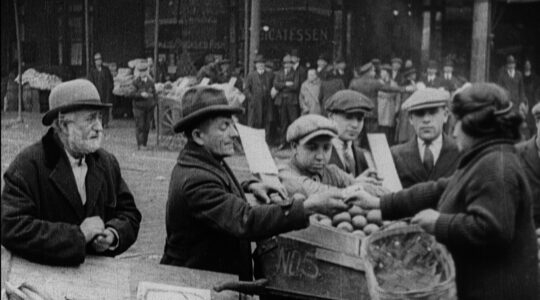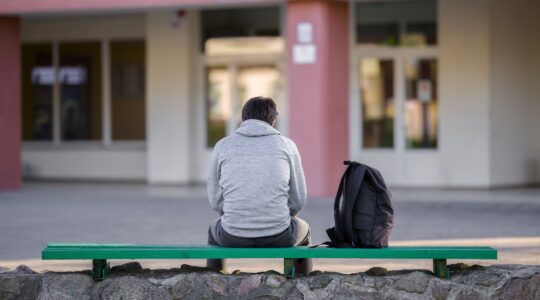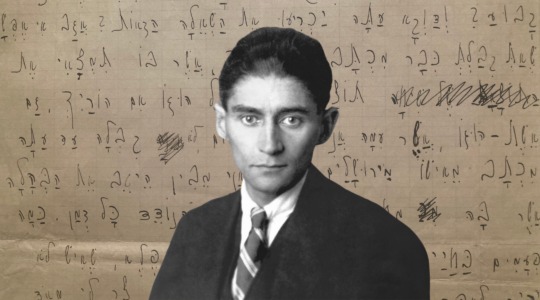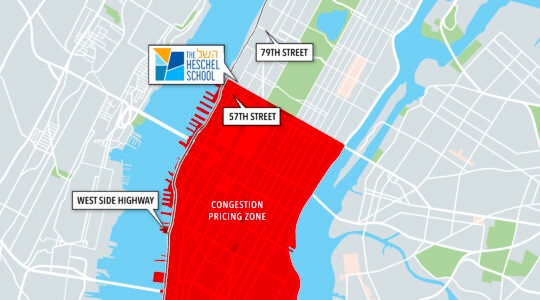Fifteen months ago, with Lower Manhattan engulfed in ashes, the idea of building a Jewish community center here might have seemed like a bizarre joke.
Jewish parenting classes, arts programming (maybe even a swimming pool) within blocks of the most horrific scene of Islamic fundamentalist-inspired destruction?
But, ironically, momentum is now building for a Jewish center below Canal Street: and it is because of, rather than in spite of, the Sept. 11 attacks.
Backers of the proposed center (still in the early stages and without funding) say that the trauma of the terrorist attacks has created a desire for connection and community among the many young Jewish families living downtown. In addition, the success of the JCC in Manhattan, the vibrant Upper West Side institution that opened a year ago after more than a decade of planning and programming, has inspired many downtown to create something similar.
"Post-Sept. 11 a lot of people’s attitudes changed," said Victoria Feder, one of the leaders of the newly formed Jewish Community Project of Lower Manhattan. "In an area that prided itself on being unaffiliated, all of a sudden that lack of affiliation made people feel untethered. People were looking for something to hook them in."
Last summer, when Feder became president of the Synagogue for the Arts, an Orthodox congregation in Tribeca, she set community outreach as a top goal. But she soon discovered that many of the area’s Jews were hesitant to step into any synagogue, let alone an Orthodox one. So Feder contacted Iris Richman, president of the Downtown Synagogue, a Conservative congregation that meets in Battery Park City, to see if they could collaborate on community programming.
The JCP was born, and with it, dreams of a full-scale community center. So far, JCP has hosted two community events (a mitzvah day and a Dec. 25 "Tevet Festival" that attracted about 70 people) but its vision is decidedly more ambitious.
In addition to area synagogue leaders, the JCP, which is applying for a grant from UJA-Federation of New York, has drawn support from the Educational Alliance, JCC in Manhattan, 92nd Street Y: and even Michael Dorf, the founder and CEO of the well-known Tribeca forward-thinking musical venue, The Knitting Factory.
Dorf, whose club has hosted a lot of cutting-edge Jewish musical events, recently joined the Downtown Synagogue and lives in Tribeca with his wife and twin 4-year-olds. He said he is excited at the prospect of a Jewish institution that will draw Jews who, like him, are more interested in the cultural than religious aspects of Judaism.
Growing up in suburban Milwaukee, Dorf fondly recalls frequent visits to his local JCC and summers at a JCC summer camp.
"Synagogues are very important parts of Judaism, but not the be-all and end-all," he said.
Talk of a JCC comes at a time of change (and opportunity) downtown. It is still not clear what kind of development will emerge at Ground Zero, and how much new housing and business space will spring up, and much of the government and charitable funding designated in the aftermath of the Sept. 11 attacks has yet to be allocated.
Independent of the JCP, the Museum of Jewish Heritage, in Battery Park City, is in the midst of a major expansion that will allow it to dramatically step up its cultural programming. (See related article on page 12.) In addition, Community Board No. 1 (concerned by the lack of public venues in the neighborhood) is also exploring the possibility of creating a community center, and the 92nd Street Y is one of the institutions submitting a proposal to implement it.
Amid so much uncertainty, it is not clear if the JCP project and community board one will eventually merge. And those involved with both projects acknowledge that they still need to do extensive research and trial programming to determine exactly what the community’s needs and desires are.
No statistics are available on the numbers of Jewish families filling the swanky modern high-rises of Battery Park City and the sprawling lofts of Tribeca. Even the total population of the area is unknown, with the last official count (approximately 120,000) taken before Sept. 11. Nonetheless, Jewish leaders here say the largely prosperous, unaffiliated and youthful Jewish community here had been steadily growing before Sept. 11 (and despite a flurry of departures in the immediate aftermath) remains sizeable.
The Downtown Synagogue recently started a small Hebrew school and, together with the Educational Alliance, the Synagogue for the Arts will open the neighborhood’s first Jewish nursery school this fall. The Educational Alliance reports that there has also been strong interest in the parenting groups and post-Sept. 11 chaplaincy programs it runs downtown.
Lower Manhattan residents say they were attracted to the area by its public schools, striking views, artistic community and (before Sept. 11) a quieter feel than traditional Manhattan Jewish enclaves like the Upper West Side or Upper East Side.
"Downtown (and Tribeca especially) it’s an amazing place to live," Dorf said. "There are a lot of families and good schools. It’s not crowded and crazy like the Upper West Side."
Feder, who has three small children, said she moved to the neighborhood seven years ago "partly to break away."
"There are great spaces available here. It’s a little bit of a break from New York. It’s known as Triburbia. It feels a little bit calmer, quieter. It’s a very neighborhood-y place."
Despite the strong Jewish presence here, the Jews below Canal Street have long felt neglected by the larger Jewish community of New York.
"People don’t know there are Jews down here," Feder said, adding, "We have to make a lot of noise to get some attention."
Technically, Tribeca and Battery Park City fall under the auspices of the Educational Alliance and the Downtown Kehilla, a consortium of synagogues and Jewish institutions below 14th Street. However, the below-Canal Street set complains that the Downtown Kehilla is more oriented towards residents of the Village, Soho, Union Square and even Gramercy Park.
Much of the Downtown Kehilla programming (such as a recent weekend-long Jewish Cultural Shuk) is based out of the Sol Goldman Y, whose East Village location requires a subway transfer or two buses for Battery Park City and Tribeca residents to get there.
However, Robin Bernstein, executive director of the Educational Alliance, argues that her group has sought to reach the below-Canal Street crew over the years, and particularly after Sept. 11.
"We’ve been open to programs," outside of the building, "but for whatever reason (whether our publicity or marketing or whatever) [the below-Canal Street residents] have not felt their voice has been heard," she said.
Until Sept. 11, Bernstein said, the Canal Street divide was also fueled by the ambivalence of the neighborhood’s "free-spirited" Jews, many of whom are secular and not sure how involved in Jewish life they wish to be.
The community has "Jews that could have afforded to live on the Upper West Side or Upper East Side but chose to live downtown where there are not a lot of organized Jewish programs," Bernstein said. "After Sept. 11, that feels different and people are looking for community in a way we haven’t experienced before. Unfortunately out of crisis comes opportunity. There may be an opportunity now to organize this previously unorganized community."
With so much still up in the air it is unclear exactly what sort of institution the JCP may emerge into, and when. In the meantime, activists say they would like to split their focus between researching long-term community needs and offering interim programs, such as parenting groups and cultural/holiday events housed in venues such as the Synagogue for the Arts, the Knitting Factory and possibly the Museum of Jewish Heritage. The Downtown Synagogue does not have a building.
"We’re starting by thinking of this as a community center without walls, but we hope the walls will follow as soon as possible," Richman said.
Debby Hirshman, who as executive director of the JCC in Manhattan has been advising the JCP, called the effort (which she compares to where her institution was 12 years ago) "very exciting."
A downtown JCC will offer people "experiences that allow for continued healing from 9-11 but also to allow for real networking and connections to be created so in times of crisis there’s a collective as opposed to the isolation people experienced after 9-11."
What lessons can she offer from the JCC in Manhattan’s experience? "The fact that you grow person to person and allow the people to help be the architects of both the program and the growth and also the need up front to put out a commitment to diverse community."
Sol Adler, executive director of the 92nd Street Y, said a great deal of research (and coordination among various institutions) is necessary before the community center can be built.
"Whoever actually does it needs to do a lot of homework to see what the community actually needs, what they want, what kind of market there is today and what kind of market there will be tomorrow."
In addition, Adler noted, Lower Manhattan is no ordinary Jewish community. "A lot of what’s happening there is happening because of a traumatic event," he said. "It’s going to be an unusual community-cultural center because it will belong to the community but also the world."
The New York Jewish Week brings you the stories behind the headlines, keeping you connected to Jewish life in New York. Help sustain the reporting you trust by donating today.




